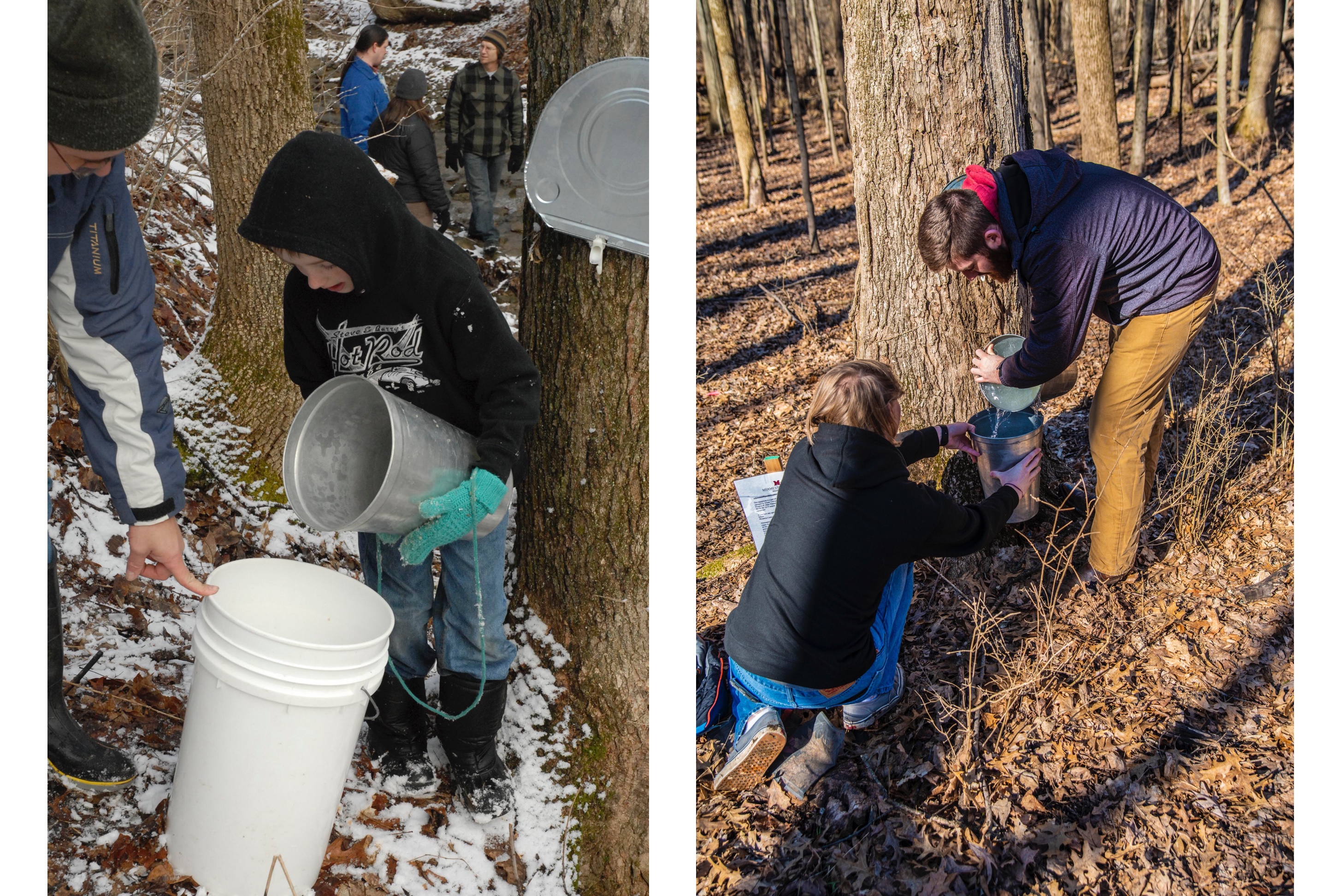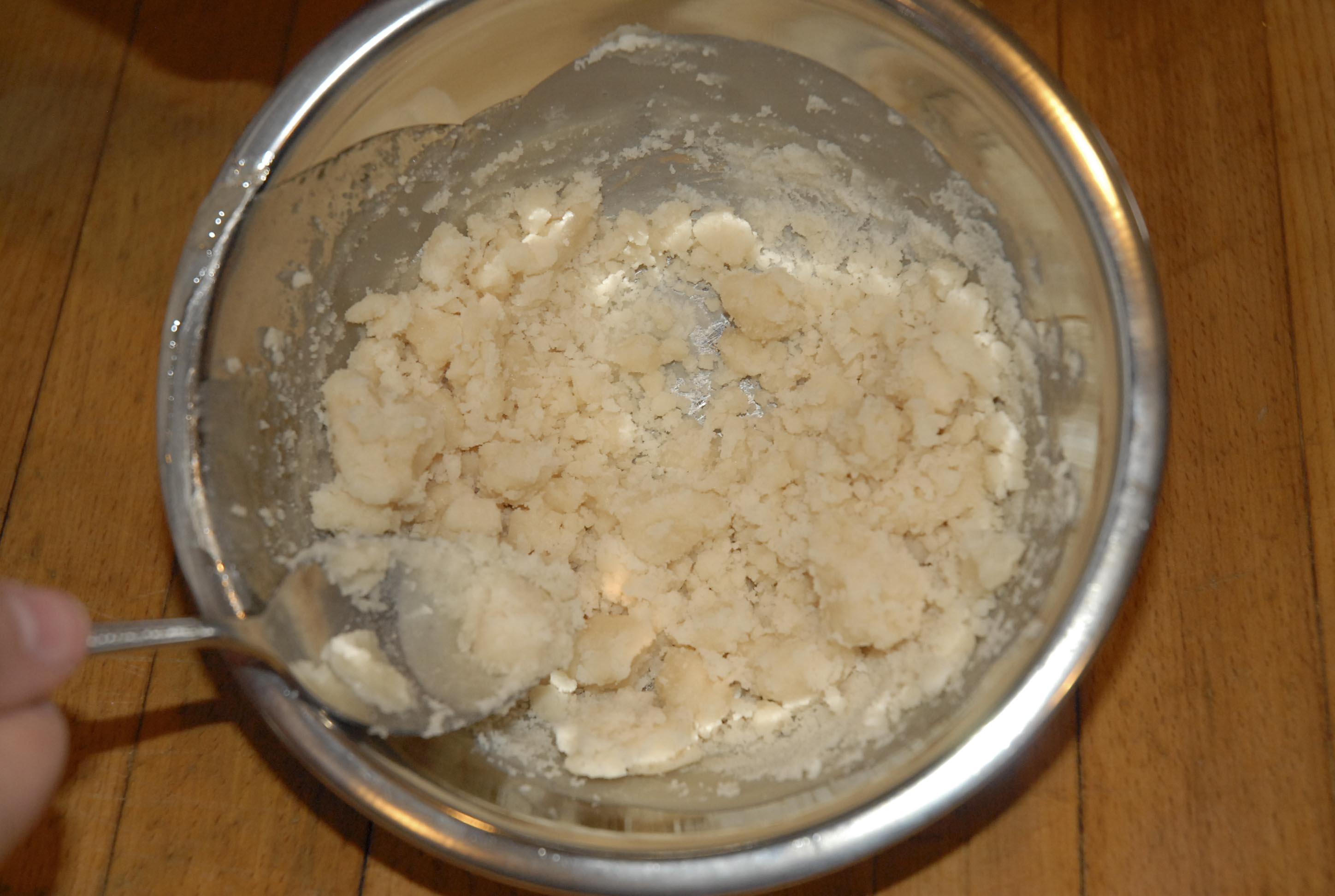We just finished cleaning up our siihsipaahkwikaani ‘maple sugar camp’ at Miami University. Maple sugaring season tends to be during Mahkoonsa Kiilhswa ‘Young Bear Moon’ and Aanteekwa Kiilhswa ‘Crow Moon’ which roughly corresponds with February through early April on the Gregorian calendar. This is the time of the year where temperatures are starting to rise during the day and drop at night. The temperature change causes ahsenaamišipowi ‘sap’ to flow from the roots of the trees up to the branches and back down.

From left to right: Gloria, Gabriel, and Josh at Miami University
Photo: Jonathan Fox, 2019
Since 2010, Myaamia Heritage students and Myaamia Center staff have regularly tapped trees in a small ahsenaamišahki ‘sugar maple grove’ on campus. This year, George and Doug Peconge identified around 30 ahsenaamiša ‘sugar maples’ to tap in rotation each year. Doug took the GIS coordinates of all the trees so that we can create maps to aid in future rotations. Having the trees close together is beneficial so that it is easier to collect and transport the ahsenaamišipowi to be processed.
The next step after identifying which ahsenaamiša will be used is tapping the selected trees. At Miami University, we used a drill to make a hole 2-3 inches into the tree at a slight angle.

Joshua S. drilling a hole for tapping at the Eichel Property outside of Oxford
Photo: Karen Baldwin, 2007
A tap was then put into the hole. The angle of the hole allows the ahsenaamišipowi to run down the tap and into the ahkihkwi ‘bucket.’Before metal and plastic were available, bark was formed into a bucket to catch the sap. Gerard Hopkins noted in the spring of 1804, “Their troughs for catching the sugar water as it is called, are made of the bark of the red elm, they are made thin, and the ends tied together.”[1] We know from other evidence that the American elm species was the most common bark used for making sugar troughs and sugar baskets for storing the finished product.

ahsenaamišipowi ‘sap’ flowing from a tap
Photo: Karen Baldwin, 2007
Throughout maple sugaring season, it is important to pay attention to the weather. Large changes in temperature will cause the ahkihkwa to fill faster than if the temperature stays relatively the same. Once the ahkihkwa are full, the ahsenaamišipowi is poured into five gallon buckets to bring back for processing.

Gabriel transferring ahsenaamišipowi ‘sap’
Photo: Left – Karen Baldwin, 2007; Right – Jonathan Fox, 2019
The process of transforming ahsenaamišipowi into iihkisaminki ‘syrup’ takes a lot of patience. The ahsenaamišipowi is put into a large cooking pot and brought to a boil. Ahsenaamišipowi is made of paankosaakani ‘sugar’ and nipi ‘water’. If you taste the ahsenaamišipowi as it runs out of the tap, you may not notice it has a sweet taste.

Gloria tasting ahsenaamišipowi ‘sap’ from the tap
Photo: Left – Karen Baldwin, 2007; Right – Jonathan Fox, 2019
When you start boiling the ahsenaamišipowi, the nipi evaporates causing the sugar to become more concentrated causing the liquid left behind to taste sweeter. With time, practice, and a good hydrometer, you’ll eventually get maple syrup. To get one gallon of iihkisaminki, you will need about forty gallons of ahsenaamišipowi.

ahsenaamišipowi ‘sap’ on the left and iihkisaminki ‘syrup’ on the right
Photo: Karen Baldwin, 2007
If you continue to boil the iihkisaminki, you can create siihsipaahkwi ‘maple sugar’. This process takes more practice in order to identify the perfect time to remove the iihkisaminki from heat and transfer into a nipoopilaakani ‘mixing bowl’. Once the liquid is transferred, it needs to be stirred constantly as it cools in order to break apart the clumps of siihsipaahkwi into finer crystals.

siihsipaahkwi ‘maple sugar’
Photo: Karen Baldwin, 2007
Historically, siihsipaahkwi was stored in wiiphšinaakana ‘basket for storing maple sugar’ and used to season food throughout the year. Two hundred years ago, Siihsipaahkwi was also traded for other goods. For example, in the spring of 1804, Gerard Hopkins noted “The women bring sugar, which is generally neatly packed in a square box made of bark, containing about fifty pounds….We have seen very white and clear looking sugar of their manufacture.”
Today, the Myaamia Heritage students and Myaamia Center staff enjoy a waffle and pancake day with the fresh iihkisaminki collected on campus!

iihkisaminki ‘maple syrup’
Photo: Karen Baldwin, 2007
Miami University Siihsipaahkwikaani
| Year | Ahsenaamišipowi Collected | Iihkisaminki Made |
| 2019 | 200 gallons | 5 gallons |
| 2020 | 171 gallons | ~4 gallons |
| 2021 | ~200 gallons | ~5 gallons |
| 2022 | ~150 gallons | ~3 gallons |
[1]Gerard T. Hopkins, A Mission to the Indians, from the Indian Committee of Baltimore Yearly Meeting, to Fort Wayne, in 1804. Compiled by Martha E. Tyson in 1862 (Philadelphia, T.E. Zell, 1862), 62. You can find this document online here – https://archive.org/details/missiontoindians00hopk_0/page/62
Related Posts:
- Maple Sugaring: Myaamia Student Perspectives
- Eehsenaamišipoohkiiyankwi (Meeloohkamiki 2021) ‘Maple Sugaring (Spring 2021)’
- eehsenaamišipoohkiiyankwi (meeloohkamiki 2022) ‘Maple Sugaring (Spring 2022)’
Updated: March 15, 2022